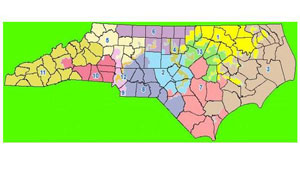
RALEIGH, N.C. (AP) - Attorneys for those who challenged North Carolina's boundaries for General Assembly and congressional seats began making arguments over the heart of the litigation Monday, accusing out-of-state mapmakers of creating lines that diminished the influence of black voters.
Democratic voters and civil rights and election advocates want a three-judge panel hearing the case to declare the maps unconstitutional - even while the maps increased black representation in the legislature. Their attorneys argued Republican lawmakers illegally packed black voters into sprawling districts, split voting precincts, and failed to keep whole counties within districts.
The latest once-a-decade rewrite of the boundaries, done by legislators based on U.S. census, data turns back "substantial but incomplete progress" in eliminating racial animosity in North Carolina, said Anita Earls, a Durham attorney representing the National Association for the Advancement of Colored People and other groups.
Republicans have argued in court documents and the 2011 redistricting debate that federal laws and recent court cases require majority-black districts whenever feasible and protect against legal challenges. But Earls said mapmakers broke the law by making race the predominant factor in their decision-making, segregating voters on a block-by-block basis.
"The overwhelming and uncontested evidence in this case demonstrates that race did predominate the decision about where to draw the district lines," Earls said.
Earls and another attorney spent the first few hours of the hearing showing multicolored maps of jaggedly-shaped districts on a computer screen to judges, saying they show evidence of racial gerrymandering. Black voters were pulled into districts only because of the "color of their skin," not due to their political leanings, as data on that were not available to mapmakers, said Allison Riggs, another attorney.
Attorneys for GOP legislative leaders and the state want the 2011 lawsuits thrown out and were expected to argue their case later in the two-day hearing. The U.S. Department of Justice signed off on the maps based on a portion of the Voting Rights Act, which is designed to protect voters from discrimination.
The political stakes on the outcome of the litigation are huge.
The Republican-penned boundaries are supposed to be in place through the 2020 elections, giving the GOP a leg up on keeping hold of the legislature. Republicans were able to draw the maps more to their liking after winning majorities in both chambers after the 2010 elections, the first time they had done so since 1870.
The new maps helped Republicans pick up nine seats in the House and two in the Senate in the November elections. Republicans also now hold nine of North Carolina's 13 U.S. House districts, compared with six before the new maps took effect. Democrats hope to force the Republicans to redraw districts that may also allow them to push back GOP gains.
Earls and other attorneys cited in court written comments made by Sen. Bob Rucho, R-Mecklenburg, and Rep. David Lewis, R-Harnett - chairmen of their respective chambers' redistricting committees - in July 2011 to make their case.
The two wrote that census figures showing "proportionality for the African-American citizens in North Carolina," or their overall population required the creation of 24 black-majority state House districts and 10 black-majority Senate districts. The previous maps contained 10 black-majority House and zero Senate districts based on 2000 census figures.
 Maps drawn by Democrats in recent years formed districts with black voting-age populations between 40 and 50 percent - so-called "influence districts" that advocates argued put black and white voters together to form coalitions and elect favored candidates. In written arguments, attorneys for Republican legislators and the state point to an updated version of the Voting Rights Act and a recent U.S. Supreme Court ruling demand majority-black districts.
Maps drawn by Democrats in recent years formed districts with black voting-age populations between 40 and 50 percent - so-called "influence districts" that advocates argued put black and white voters together to form coalitions and elect favored candidates. In written arguments, attorneys for Republican legislators and the state point to an updated version of the Voting Rights Act and a recent U.S. Supreme Court ruling demand majority-black districts.
The same panel of three Superior Court judges decided last year to allow the 2011 maps to be used during the 2012 elections. Rulings by the panel likely will end up at the state Supreme Court, where a majority of justices are Republican by voter registration.
Eddie Speas, an attorney representing the Democratic voters, said the chief architect of the maps was Thomas Hoefeller, redistricting coordinator for the Republican National Committee for the 1990, 2000 and 2010 map cycles. Speas said Hoefeller mostly worked on the maps in Washington or at his home in Virginia - suggesting out-of-state influences.
Copyright 2013 The Associated Press.
